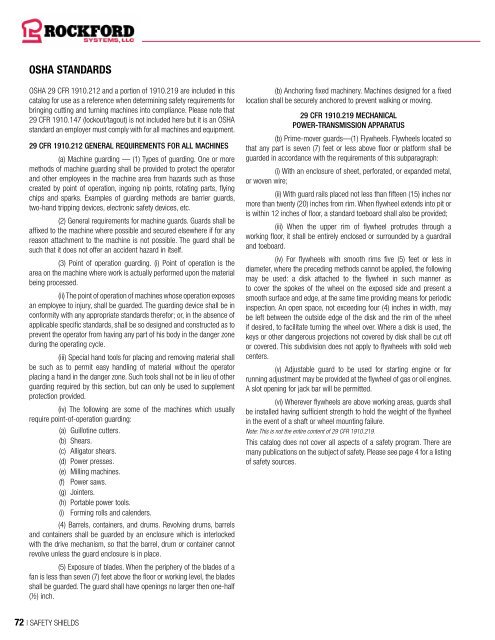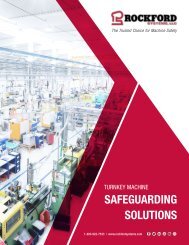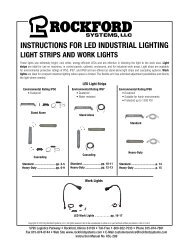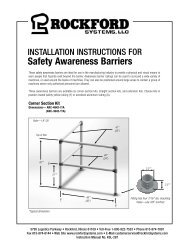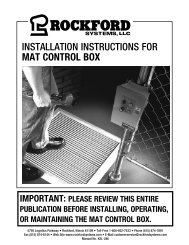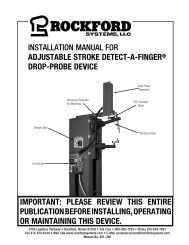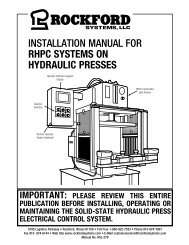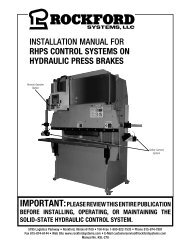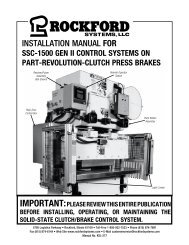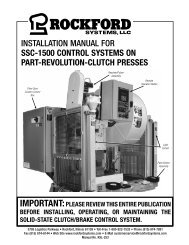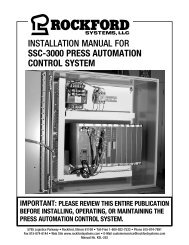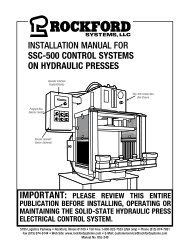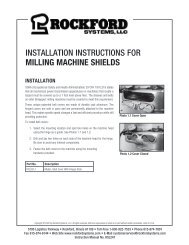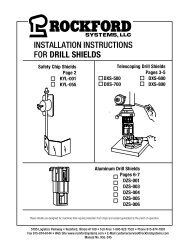Rockford Systems Shields for Safeguarding Machines Catalog
FREE, comprehensive 80-page catalog that features a complete line of equipment to protect operators of cutting and turning machines. These products comply with OSHA and ANSI standards. The polycarbonate and steel shields found in this catalog can be applied to drill presses, lathes, milling machines, bench grinders, band saws, and disc and belt sanders. The catalog also offers emergency-stop devices, disconnect switches, magnetic motor starters, lockouts, and danger signs.
FREE, comprehensive 80-page catalog that features a complete line of equipment to protect operators of cutting and turning machines. These products comply with OSHA and ANSI standards. The polycarbonate and steel shields found in this catalog can be applied to drill presses, lathes, milling machines, bench grinders, band saws, and disc and belt sanders. The catalog also offers emergency-stop devices, disconnect switches, magnetic motor starters, lockouts, and danger signs.
- No tags were found...
You also want an ePaper? Increase the reach of your titles
YUMPU automatically turns print PDFs into web optimized ePapers that Google loves.
OSHA STANDARDS<br />
OSHA 29 CFR 1910.212 and a portion of 1910.219 are included in this<br />
catalog <strong>for</strong> use as a reference when determining safety requirements <strong>for</strong><br />
bringing cutting and turning machines into compliance. Please note that<br />
29 CFR 1910.147 (lockout/tagout) is not included here but it is an OSHA<br />
standard an employer must comply with <strong>for</strong> all machines and equipment.<br />
29 CFR 1910.212 GENERAL REQUIREMENTS FOR ALL MACHINES<br />
(a) Machine guarding — (1) Types of guarding. One or more<br />
methods of machine guarding shall be provided to protect the operator<br />
and other employees in the machine area from hazards such as those<br />
created by point of operation, ingoing nip points, rotating parts, flying<br />
chips and sparks. Examples of guarding methods are barrier guards,<br />
two-hand tripping devices, electronic safety devices, etc.<br />
(2) General requirements <strong>for</strong> machine guards. Guards shall be<br />
affixed to the machine where possible and secured elsewhere if <strong>for</strong> any<br />
reason attachment to the machine is not possible. The guard shall be<br />
such that it does not offer an accident hazard in itself.<br />
(3) Point of operation guarding. (i) Point of operation is the<br />
area on the machine where work is actually per<strong>for</strong>med upon the material<br />
being processed.<br />
(ii) The point of operation of machines whose operation exposes<br />
an employee to injury, shall be guarded. The guarding device shall be in<br />
con<strong>for</strong>mity with any appropriate standards there<strong>for</strong>; or, in the absence of<br />
applicable specific standards, shall be so designed and constructed as to<br />
prevent the operator from having any part of his body in the danger zone<br />
during the operating cycle.<br />
(iii) Special hand tools <strong>for</strong> placing and removing material shall<br />
be such as to permit easy handling of material without the operator<br />
placing a hand in the danger zone. Such tools shall not be in lieu of other<br />
guarding required by this section, but can only be used to supplement<br />
protection provided.<br />
(iv) The following are some of the machines which usually<br />
require point-of-operation guarding:<br />
(a) Guillotine cutters.<br />
(b) Shears.<br />
(c) Alligator shears.<br />
(d) Power presses.<br />
(e) Milling machines.<br />
(f) Power saws.<br />
(g) Jointers.<br />
(h) Portable power tools.<br />
(i) Forming rolls and calenders.<br />
(4) Barrels, containers, and drums. Revolving drums, barrels<br />
and containers shall be guarded by an enclosure which is interlocked<br />
with the drive mechanism, so that the barrel, drum or container cannot<br />
revolve unless the guard enclosure is in place.<br />
(5) Exposure of blades. When the periphery of the blades of a<br />
fan is less than seven (7) feet above the floor or working level, the blades<br />
shall be guarded. The guard shall have openings no larger then one-half<br />
(½) inch.<br />
(b) Anchoring fixed machinery. <strong>Machines</strong> designed <strong>for</strong> a fixed<br />
location shall be securely anchored to prevent walking or moving.<br />
29 CFR 1910.219 MECHANICAL<br />
POWER-TRANSMISSION APPARATUS<br />
(b) Prime-mover guards—(1) Flywheels. Flywheels located so<br />
that any part is seven (7) feet or less above floor or plat<strong>for</strong>m shall be<br />
guarded in accordance with the requirements of this subparagraph:<br />
(i) With an enclosure of sheet, per<strong>for</strong>ated, or expanded metal,<br />
or woven wire;<br />
(ii) With guard rails placed not less than fifteen (15) inches nor<br />
more than twenty (20) inches from rim. When flywheel extends into pit or<br />
is within 12 inches of floor, a standard toeboard shall also be provided;<br />
(iii) When the upper rim of flywheel protrudes through a<br />
working floor, it shall be entirely enclosed or surrounded by a guardrail<br />
and toeboard.<br />
(iv) For flywheels with smooth rims five (5) feet or less in<br />
diameter, where the preceding methods cannot be applied, the following<br />
may be used: a disk attached to the flywheel in such manner as<br />
to cover the spokes of the wheel on the exposed side and present a<br />
smooth surface and edge, at the same time providing means <strong>for</strong> periodic<br />
inspection. An open space, not exceeding four (4) inches in width, may<br />
be left between the outside edge of the disk and the rim of the wheel<br />
if desired, to facilitate turning the wheel over. Where a disk is used, the<br />
keys or other dangerous projections not covered by disk shall be cut off<br />
or covered. This subdivision does not apply to flywheels with solid web<br />
centers.<br />
(v) Adjustable guard to be used <strong>for</strong> starting engine or <strong>for</strong><br />
running adjustment may be provided at the flywheel of gas or oil engines.<br />
A slot opening <strong>for</strong> jack bar will be permitted.<br />
(vi) Wherever flywheels are above working areas, guards shall<br />
be installed having sufficient strength to hold the weight of the flywheel<br />
in the event of a shaft or wheel mounting failure.<br />
Note: This is not the entire content of 29 CFR 1910.219.<br />
This catalog does not cover all aspects of a safety program. There are<br />
many publications on the subject of safety. Please see page 4 <strong>for</strong> a listing<br />
of safety sources.<br />
72 | SAFETY SHIELDS


